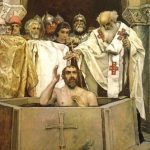 Technology
Technology  Technology
Technology  Humans
Humans 10 Everyday Human Behaviors That Are Actually Survival Instincts
 Animals
Animals 10 Animals That Humiliated and Harmed Historical Leaders
 History
History 10 Most Influential Protests in Modern History
 Creepy
Creepy 10 More Representations of Death from Myth, Legend, and Folktale
 Technology
Technology 10 Scientific Breakthroughs of 2025 That’ll Change Everything
 Our World
Our World 10 Ways Icelandic Culture Makes Other Countries Look Boring
 Misconceptions
Misconceptions 10 Common Misconceptions About the Victorian Era
 Mysteries
Mysteries 10 Strange Unexplained Mysteries of 2025
 Miscellaneous
Miscellaneous 10 of History’s Most Bell-Ringing Finishing Moves
 Technology
Technology Top 10 Everyday Tech Buzzwords That Hide a Darker Past
 Humans
Humans 10 Everyday Human Behaviors That Are Actually Survival Instincts
 Animals
Animals 10 Animals That Humiliated and Harmed Historical Leaders
Who's Behind Listverse?

Jamie Frater
Head Editor
Jamie founded Listverse due to an insatiable desire to share fascinating, obscure, and bizarre facts. He has been a guest speaker on numerous national radio and television stations and is a five time published author.
More About Us History
History 10 Most Influential Protests in Modern History
 Creepy
Creepy 10 More Representations of Death from Myth, Legend, and Folktale
 Technology
Technology 10 Scientific Breakthroughs of 2025 That’ll Change Everything
 Our World
Our World 10 Ways Icelandic Culture Makes Other Countries Look Boring
 Misconceptions
Misconceptions 10 Common Misconceptions About the Victorian Era
 Mysteries
Mysteries 10 Strange Unexplained Mysteries of 2025
 Miscellaneous
Miscellaneous 10 of History’s Most Bell-Ringing Finishing Moves
10 Tales from the Lives of the Desert Fathers
The teachings of Jesus contained in the Bible can easily be interpreted as showing a disdain for the things of this world and promoting asceticism among his followers. When a rich man asks Jesus what he should do to achieve eternal life, Jesus tells him to sell all he has and give the money to the poor. When Jesus sends out his disciples, he tells them not to take money or bread or even a change of clothes, nothing but a walking staff. For some early Christians, lessons like these made them abandon their lives and retreat to pray in the deserts of the Middle East.
Despite living like hermits, many of these Desert Fathers and more than a few Desert Mothers gained fame and followers. Here are ten isolated saints with fantastic stories about them.
Related: Ten Terrible Fates of History’s Most Famous Martyred Saints
10 Paul of Thebes
Early Christian authors say that the first believer to retreat into the desert was Paul of Thebes. He lived in Egypt in the 3rd century when the Roman emperor Valerian was persecuting Christians. He was only around 16 when soldiers started torturing and slaying Christians in his hometown. As a wealthy young man, he was quickly targeted but fled to his brother-in-law’s home for protection. Instead of helping Paul, however, the brother-in-law turned him in with hopes of receiving a large inheritance. Paul escaped and ran to the mountains.
In the wilds, Paul discovered a cave with a spring in it and a palm tree growing through the roof. The palm gave him his only food for decades—until a raven started bringing him half a loaf of bread per day. According to his biographers, he lived completely alone until he was 113 years old when God prompted another desert hermit called Anthony to pay him a visit. Paul knew God had ordained the meeting because that day, the raven brought a whole loaf of bread for them to share. Within days, Paul died, one assumes, of extreme old age, and Anthony saw his soul ascending into heaven supported by angels.
A monastery was soon built on the site of Paul’s cave, and it can still be visited to this day. His body and relics remain in the cave.[1]
9 John the Dwarf
John the Dwarf, or John the Short, was also born in Thebes in Egypt, but in the 4th century. Instead of coming from a wealthy family, his parents were poor but holy, and John was inspired by them to seek isolation to devote himself to God. In the desert, he found a hermit called Pemouah and asked to be taught how to become holy. At first, Pemouah tried to dissuade John from the hermetic life, but an angel appeared to persuade him.
To give John a taste of the obedience and meekness that was expected of him, Pemouah gave him a piece of dried wood and told him to plant it in the ground and water it every day. John did this despite the seemingly pointless nature of the task—and the fact that the nearest source of water was 12 miles (19 km) away. For three years, John continued watering the wood until it miraculously began to put out green shoots. Decades later, visitors claimed to have seen this tree and tasted the fruit from it.[2]
8 Apollinaris of Egypt
According to the probably apocryphal story of Apollinaris of Egypt, she started her path to holiness as a young girl. Coming from a wealthy and powerful Roman family, she refused to marry the man chosen for her by her parents and told them she wished to live as an ascetic. They finally relented and allowed her to travel into the desert to become a recluse. As soon as she was in Egypt, she freed her slaves and took a monk’s habit. As soon as she was alone, she dressed like a monk and secretly joined a community of male hermits, taking the name Dorotheus.
Apollinaris’s sister became possessed by a demon, and the leader of the desert community sent the “monk” Dorotheus to heal her. Apollinaris cast out the demon and left—but the demon returned and said that the girl had been assaulted by Dorotheus. The scandalized parents sent soldiers to drag the monk back to them for punishment. It was only then that Dorotheus revealed that she was really Apollinaris, and her parents allowed her to return to the desert. Apollinaris lived the rest of her life as Dorotheus, and her fellow monks only discovered the truth when preparing her body for burial.
It is thought that the legend of Apollinaris is based on the life of Syncletica of Alexandria, a wealthy young woman who took to asceticism against her parents’ wishes. She cut her hair short in a manly style to ensure no man married her.[3]
7 Macarius of Egypt
Macarius, born around AD 300 in Egypt, started his life as a cattle herder near the desert. It was there that he fell in love with the wilderness and solitude, but his family demanded that he get married. Macarius did wed but pretended to be ill to avoid having to sleep with his bride. When she soon died, Macarius gave away all his money and traveled into the desert.
Macarius became well known for his asceticism, but one day, a girl (apparently possessed by a demon) accused him of getting her pregnant. Local villagers beat Macarius for his crime, but he simply accepted their accusations without argument. When the girl went into labor, it was a difficult birth, and the mother’s life was in danger. Only when she retracted her claims was the baby delivered. When Macarius died, he was recognized as a saint, and people in a nearby village stole his corpse and built a church on top of it.
Images of Macarius sometimes show him as a wild man, with long hair covering his entire body to show his tough life in the desert.[4]
6 Arsenius the Great
Arsenius was born in Rome around AD 350 and did not suffer for faith as others had done. By the time he reached adulthood, the Roman Empire was converting to Christianity, and he was chosen to educate the children of Emperor Theodosius the Great. In such a high position, he became wealthy and was decked out in fine clothes, but Arsenius wanted to live a simple life. He dressed in rags, snuck out of the palace, and set sail for Egypt.
In Egypt, he sought out monks in the desert and was taken to John the Dwarf. Despite Arsenius’s protestations of wanting to be a hermit, he still spoke like a noble of the court. So John decided to test his commitment. When the other monks were served a meal, John tore off a crust of old bread, threw it on the floor, and told Arsenius to eat that. Arsenius got on his hands and knees and did. This convinced John, so Arsenius joined the community.
Arsenius led a mostly solitary life, only going to church with the other monks on Sundays, and made his life as uncomfortable as possible. He used palm fronds to weave baskets and never changed the water he used to soak them—making his cell stink. When asked why he did this, he said it was punishment for the perfumes he used when in Rome.[5]
5 Bishoy
Saint Bishoy, or Pishoy, was born in Egypt around AD 320. He had several older brothers who were healthy and strong, but Bishoy was always sickly and small. When an angel appeared to his mother and demanded a son be given in service to God, she pointed to one of her strapping lads, but the angel chose Bishoy instead. After serving with a spiritual teacher for several years, an angel led Bishoy into the desert and pointed to where he should live as a hermit.
Bishoy became famous for his piety and asceticism, and soon, many other hermits moved to be close to him. To avoid falling asleep while praying, he tied his hands and hair to the ceiling of his cell. Because of his holiness, Bishoy is said to have seen Jesus several times. When his fellow hermits heard of this, they wanted to see Jesus for themselves. The next time Bishoy was told Jesus would appear, he told his friends to gather at a certain point to witness it. On their way, the monks passed an old man asking for help—but they simply walked by. When Bishoy saw the old man, he offered to carry him on his back, at which point the old man revealed that he was really Jesus.
Bishoy is sometimes referred to as “the perfect man.” When he died, his body is said to have stayed intact and incorruptible. Though not on public display, it is said to be in remarkable condition even today.[6]
4 Anthony the Great
Though Paul of Thebes is said to be the first to move to the desert for solitude and prayer, it is Anthony the Great who is regarded as the Father of Monasticism. In common with many hermits, he is said to have been rich and given away all his possessions before retreating to the desert.
A text known as The Life of St Anthony tells us that he spent his early years visiting other Desert Fathers to see what he could learn about their way of life. Once he had learned all he could, he retreated into solitude—but he could not hide from the Devil. We are told that whole hosts of demons appeared to Anthony to attack him and distract him from his devotions. The Devil is even said to have appeared in the form of a beautiful woman to inspire lust. St. Anthony is said to have passed all these tests of his faith. Medieval art of the saint tends to show him looking bored as he attempts to ignore legions of bizarre devils pulling at him.
Others soon gathered near St. Anthony’s retreat and begged him to give them instructions on how to live. The community which he developed in the desert formed the model for later Christian monasteries.[7]
3 Poemen the Great
Some of the Desert Fathers come across as harsh and austere in their dealings with others, but Poemen the Great is noted for his kindness and forgiveness. Living with a community of monks in Egypt, he preferred to offer advice rather than command punishments when they erred. His method must have been popular as many of his sayings have survived as quotations.
When one monk came to declare that he had sinned and needed to spend three years performing repentance, Poemen said that if he truly sought forgiveness from God, then three days of penance was enough. Another monk asked how Poemen punished those who fell asleep while praying. Poemen replied that he rested their head in his lap so that they could get some rest.[8]
2 Moses the Black
The 4th-century saint known as Moses the Black, or Moses the Robber, started life as a slave and a renowned rascal. While young, he was accused by his master of stealing things, so he was cast out of the household. Alone in the world, he gathered a group of men around him and lived the life of a bandit, robbing travelers and stealing livestock. It is not known how Moses came to Christianity, but while fleeing retribution, he may have encountered holy men in the wilderness and decided to join them.
Though Moses became a hermit, he did not forget the skills he had learned in his previous profession. When his old gang broke into his cell to attack him, Moses managed to overpower them, tie them up, and drag them into the church to ask what he should do with them. No wonder he is also known as Moses the Strong. Impressed by his mercy at not killing them, the whole gang converted on the spot.[9]
1 Simeon Stylites
What are you to do if you find that your isolation in a monastery is not quite isolated enough? If you are Simeon Stylites, then you retreat to a high pillar to separate yourself physically from others. Simeon was known for extreme acts of asceticism, like locking himself away, fasting for long periods, and standing in prayer until he collapsed.
Praying until you fall down and staying on top of a tall pillar seems like a combination destined to bring about disaster. So Simeon used to tie himself to the pillar with a rope. This rope was so coarse that it cut deeply into his flesh, and Simeon refused to wash the wound, so maggots and worms infested it. In one story, a king came to visit Simeon to ask for advice, and one of the wriggling maggots fell on him. As he went to pick up the maggot, it was miraculously turned into a pearl.
Perhaps one of the oddest aspects of Simeon’s lifestyle is that it caused a whole host of copycats. Soon, anyone with any aspirations to become a holy man was building themselves a pillar of their own.[10]








